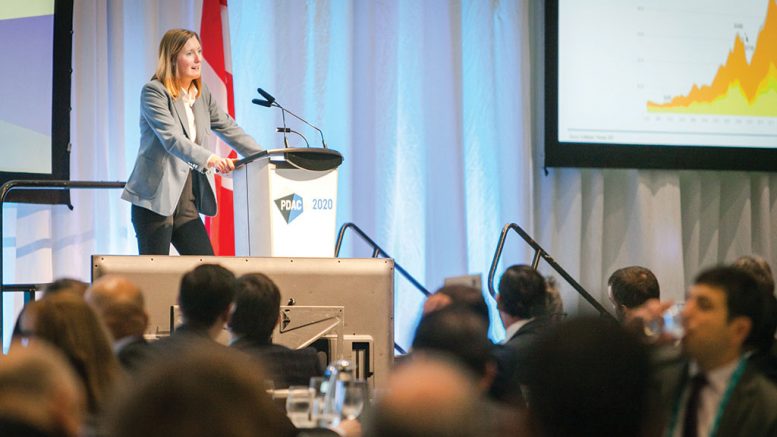Last year was the busiest year for mergers and acquisitions in the precious metals sector since 2010, Catherine Raw, the executive responsible for Barrick Gold‘s (TSX: ABX; NYSE: GOLD) North America region, told a luncheon at the Prospectors & Developers Association in Toronto on Mar. 2.
Over the last eighteen months, the market has witnessed the $5 billion merger of Randgold Resources and Barrick Gold; the $13 billion joint-venture between Barrick and Newmont (NYSE: NEM) in Nevada; and Newmont’s $12.5 billion takeover of Goldcorp, along with 27 other transactions in the space, she said.
“These aren’t mega in the broader market but they’re mega in our industry,” Raw noted. “What we’ve seen is a pick-up in activity that is really quite remarkable. That consolidation will continue and I believe it will spread into the mining industry as a whole because they are facing many of the same challenges that the gold industry is facing.”
The accelerated M&A activity has been driven largely by the portfolio rationalizations of companies like Barrick and Newmont as they sell assets; the Australians, who have taken advantage of strong paper and strong balance sheets to try to deliver the same returns they’ve been able to deliver in their own operations around the world; and by the Chinese who continue to increase their global presence, she said.
“M&A is back,” declared Raw, who joined Barrick as chief financial officer in May 2015. Prior to Barrick, Raw was in the fund management business, and co-managed BlackRock’s flagship mining funds. She has also worked for Anglo American in London and Johannesburg, and as a geological assistant in Sweden.
The mining executive noted that the industry now has a gold price that has stabilized with a floor of US$1,200-$1,300 per oz., with the potential of heading into a bull market that allows the industry to plan for the future and consider how to add value for their shareholders over the long term. But it won’t be easy.
“The industry faces an environment where a depleting asset base, a lack of new discoveries and a deteriorating quality of reserves means that inorganic growth is really the only solution versus organic growth,” she said.
The gold industry has stabilized over the last five years and readjusted to a new price floor and is now looking to plan its business going forward at that level and consider what opportunities it has in front of it. “What’s relevant here is how the production for the industry, despite rising gold prices, is plateauing.”
“What we’ve seen is that the growth that was really driven from the 2004-2008 period has now come through into production, and even despite stable to rising gold prices, we’re not seeing that next generation of projects coming through in the pipeline, so the forecast is that production will start falling … And even with higher prices, apart from alluvial production where you do see very elastic response to prices, particularly out of Russia, the industry is inelastic. It’s not price sensitive. We’ve probably got a seven-year, if not ten-year, lead time to new projects, and that is very much dependent upon what the exploration pipeline looks like. So then you look at what are the new discoveries we’ve seen over the last decade. Do we have a pipeline to be able to supply the industry going forward and the answer is no.”
Even when the gold price was up to US$1,900 per oz. in the previous cycle, and even now when the gold price is over US$1,600 per oz., she said, there have been very few major discoveries globally. “We are still, effectively, living off the discoveries of the 1990s, and so the consequence of that is this: The industry is living on borrowed time, effectively. Reserves are shrinking and the quality of those reserves is deteriorating.”
Raw noted that in order to grow reserves, companies typically just changed their price assumptions. They dropped their cut-off grades and added ounces. “So then when the gold price fell we had to lower our gold price assumptions, which meant we had to increase our cut-off grades and reserves began to fall. The benefit, of course, is that the quality of those reserves went up, so if the gold price went back up, at least you’d generate a stronger margin.”

Catherine Raw, Barrick Gold’s chief operating officer for North America addresses attendees at PDAC convention in Toronto. Credit: PDAC.
“What’s interesting over the last three years is that even despite gold prices being stable to higher, even despite all of this change, we’re beginning to see grades deteriorate again,” she said. “We’re running out of the good stuff, and we’re having to start mining low grades again, so what we have got is this issue of deteriorating quantity and quality affecting the industry.”
The way companies can deal with this, she said, is through M&A and consolidation, or inorganic growth. “Barrick and Newmont are prime examples of that. We came out with our 2019 results and we were able to say we grew reserves year-on-year. But we grew a lot of those reserves through acquisition. What was interesting about Barrick relative to Newmont is that we increased the quality of those gold reserves, as well.”
“The question for the industry now is, if it’s going to consolidate, if we’re going to see this chase for inorganic growth to be able to tell the market that we are able to maintain production at current levels, [that] we are able to deliver value, you have to keep the quality of your reserves either the same or improving, unless there’s going to be some major technological or structural change to offset the deterioration of quality. But this issue — this lack of growth, this lack of new discovery, and this deterioration and depletion of existing reserves — is forcing the industry to look at one another to cannibalize in order to be able to stand still or in order to be able to prove they’re adding value to their shareholders.”
In addition, while the industry has recovered from the fall in the gold price between 2011 and 2013, which has allowed balance sheets to improve, the industry is still “incredibly leveraged relative to historic norms” and the challenge is that the industry “has spent the last five years not investing in our assets.”
Capex has been significantly lower than it has been historically, and precious metals companies have been focusing on small-scale brownfields opportunities rather than big greenfield projects. “We can only do that for so long,” she said, adding that those companies that have strong balance sheets and are able to fund that internally will be at a strategic advantage to those companies that require external sources of funding, “because if you’ve already got a leveraged balance sheet it’s going to be very hard to significantly grow debt, and if you can’t grow debt, well then you have to grow through equity capital and the question is, is that equity capital available?”
Even if companies find new projects, Raw added, they either need a balance sheet that is strong enough or they can access third party capital. “But the equity market isn’t open to gold companies in the way that it used to be,” she said. “There is a scarcity of new capital. If you look at 2019, you can see it is the lowest issuance of new capital in the Canadian base and precious metals market for over a decade.”
One of the biggest structural changes to the investor base is that the specialty funds that were really driving the funding for junior and mid-tier companies in the last cycle “have all but disappeared.”
“What we’ve seen is the memories of the last cycle, poor returns [and] low liquidity, have meant the end investor, the retail investor and the institutional investor that were providing the capital to these specialist funds, have walked away. So those funds are now not available. And what we’ve seen to take their place is increasing passive investment in the industry.”
Raw pointed out that over the last decade the industry has seen a 300% increase in passive management with over 20% of the shareholder base for the senior gold companies coming from passive investors. “What I mean by that is that they’re not willing to fund small projects here and there in the way that a precious metals fund would have done in the past. And so for the gold industry, if it can no longer rely on subject matter expert fund managers that are going to fund one-off projects here and there, you have a different risk appetite to the broader equity market. Who is it going to rely on? How does it remain relevant and how can it source capital? How can it grow? How can it take advantage of this higher price gold environment that we’re now in?”
A rising gold price has seen the sector rebound — companies are making free cash flow, balance sheets are stable — they’re increasing dividends and returning cash to shareholders. Even so, “we’re over $100-$200 billion dollars lower in market cap to where we were when the gold price was last at this level, and the reason for that is, a lack of trust by the generalist investor that we’re not going to do the same thing again. The generalist investor has moved on.”
“We’ve seen the S&P 500 [and] broader equity markets have grown significantly since the last decade,” she added. “The opportunities in the market are very different … what we’ve seen, particularly for the juniors and the developers, is a lack of interest from generalist investors. But there are no specialist investors to attract. So how can the industry remain relevant? How do we get those generalist investors back into the gold market, and what will the consequence of that be for consolidation and M&A in the future?”
As the precious metals sector struggles for relevance in broader equity markets, and while that may be less true with the outbreak of the coronavirus when everyone remembers that gold is a safe haven and a store of value, ultimately, and structurally, “the fundamental problem is there is a lack of scale and a lack of liquidity in the industry.”
Raw noted that the entire precious metals industry is worth $355 billion, which compares to single companies like Exxon ($250 billion) and Apple ($1.4 trillion); or the S&P Index ($28.7 trillion). “If you’re a fund manager, and you have a choice of where to invest, and you say, should I invest in a junior exploration company, or should I go overweight/underweight Apple, the priority is always going to be to the larger companies where you can trade in and out very quickly, where you can deal with investor outflows and inflows, where you’re not stuck and exposed to random risks like environmental disasters, or regulation issues or government taxation. The choice to take a risk in the precious metals sector given its size is a pretty off-the-wall choice to make, and so, on that basis, we have to encourage the industry and encourage the market to pay attention, and the way you can do that is to provide scale and provide liquidity, and the companies that can do that will attract premium valuations.”
You can see that in the market today, she said. If you look at the multiples of senior gold companies relative to the intermediates, there is a widening in valuation inequality, and what that does is reinforce the problem, she explained, because as the seniors become more valuable, they become more liquid, they become larger, they are able to take advantage of their premium and there will be winners and losers.
“The losers will ultimately become so cheap that you can add value through acquiring them,” she said, and, as a result, “the scale issue is encouraging intermediates to consolidate. It’s encouraging single mine producers to join with other single mine producers to create diversification to persuade investors that they’re not exposed to too much risk by owning them, and is ultimately driving what is a consolidation trend within the industry.”
The other symptom of the changing investor base, she said, is that “suddenly investors seem to have got a conscience.”
“I say that cynically because I was an investor, and none of this is new, but it’s as if we’ve only just woken up to this,” she said. “ESG is not a new phrase. Corporate governance, social responsibility, licence to operate, sustainability, these are all words that have been going on, well, at least since I came out of university. I remember I did a course on how can mining be sustainable given it is exploiting finite resources. So this challenge is really only relevant today because the specialist investors that understood these risks and could deal with these risks are no longer the marginal buyer of mining stocks. The marginal buyer of mining stocks is now either the passive fund, that needs to justify its existence in the world, and so it claims it’s that oversight and corporate governance and ESG focus that it applies to all of its investments that is the way it adds value; or it’s the generalist investor, the institution, that is not used to taking the kind of risks that exist in our industry.”
When you own a supermarket, or you own a retailer, or you own a tech company, she reflected, you don’t have the same kind of exposure. However, this can be a driver for M&A activity because investors are identifying management teams they trust — management teams that are able to mitigate or manage the risks associated with ESG issues successfully and have a track record of doing so. Those companies that slip up, however, are getting punished in a far greater way than they ever have done in previous cycles. Companies that manage ESG issues well, that believe it is part of their business, that treat it as core, are likely to outperform those companies who are just going through the motions, she continued.
Looking ahead, Raw summarized, M&A and consolidation is likely to continue. “It has to continue in order to offset what will otherwise be a depletion of the resource base in the gold industry, a disruption of value. So the only way to be able to survive is to consolidate, that gives you scale, it gives you opportunity, and it gives you liquidity, all of which are going to be much more attractive to an investor base that is not used to owning the mining space, that is not used to taking the risks, and that requires a liquidity and a risk mitigation to be able to allow them to invest in the mining industry at all.”
What the industry must do this time around is avoid making the mistakes of the past, she emphasized, if they want to encourage the generalist investor to take part, and ultimately, get the support for the consolidation the industry requires.
The first thing companies must do is avoid value-destructive premiums. “There has to be a strategic rational that is more than just that ‘we need another asset,’” she added, “and ultimately both sides of the trade have to benefit. There has to be a sharing of that value uplift in theory associated with a well-thought out transaction. And that is the only way that the industry will get support for further consolidation and therefore will be able to start the next leg of the next cycle.”
There will also need to be a focus on quality, not quantity.
“When you look at the challenges [Barrick] faced back in 2011-2013, it was this rush to get to 9 million oz. of production, this rush to be in copper, and not focusing on the quality and the nature of that asset base that ultimately led to the severe issues that the company faced when the gold price fell,” she noted. “It was overleveraged. It couldn’t generate a sufficient margin. It had to redesign its whole business, and, ultimately, it had to carve off those assets that it wasn’t able to generate a return from. So the only way we can change that paradigm and deliver value for our shareholders is to understand how we maintain or improve quality.
“And what I mean by that is, it’s not necessarily just grade. It’s margin. So you can lower your cut-off grades if you are able to lower your costs and you are able to generate margins and protect shareholders in what will still be a very volatile gold price environment going forward. That links on to obviously not taking on too much leverage. If the gold price is volatile — if we can’t predict whether the gold price is going to be US$1,600 or US$1,200 or somewhere in between — you need to be able to take the rough with the smooth. You need to be able to invest year-in and year-out. And you need to be able to access markets when required and deliver returns when the gold price is high. So the key there is obviously not taking on too much leverage, maintaining that strength of the balance sheet, maintaining that buffer that provides a shield against uncertain gold price environments in the future.”
Capital discipline is also key. “We saw a dearth of capital discipline in the previous cycle. As the gold industry starts to reinvest in its business, we need to focus on delivering those returns, on capping capital inflation, on ultimately not taking on too much risk, which leads on to the ‘execute on time and on budget.’ Easy to say, very hard to do. The norms for the previous cycle were 30% over [budget] and two years late. How do we stop that from happening again? Especially if we’re all rushing to develop at the same time again.”
To do that, she said, the nature of the projects will have to change. “Staged projects, brownfields first, and even if they are greenfields, how do you bring in partners, how do you de-risk the capital? How do you bring in governments, how do you bring in regulators to ensure that your permitting timeline doesn’t stretch out. All of this has to be thought about and engaged with in a very different way than we’re used to; otherwise, it will be just like it was last time and we’ll see the same issues and the same destruction of capital recurring. “
As for ESG, Raw noted that there are two ways of taking it on.
“One is a cynical way of looking at it, which is a discount rate applies to any project that you develop, and the way of reducing that discount rate is to mitigate your ESG issues.”
She noted that one of her former bosses in her pre-BlackRock days always told her that a mine is binary. “If you have a community that doesn’t want a mine built, it doesn’t matter what discount rate you apply, the return is going to be zero. And that is the way we used to approach ESG issues. So it wasn’t about making a difference to the world. It wasn’t about reputation. It wasn’t about any of the things that we talk about now. It was pure commercial share price performance, which is if a mine can’t generate any money, there’s no point owning it. So you want a management team that can mitigate and manage those binary risks. You know, technical issues, costs, they’re not binary. Normally you lose some of your return; you don’t lose all of your return. Financial metrics are relatively straightforward to deal with, it’s the other issues, the soft issues, the ones we don’t report on, the ones we don’t focus investors’ attention on, or didn’t use to, that really makes the difference.”
The flip side — the positive — is that in this new world, with a new generation of people coming up, with investors that aren’t used to taking risks, the mining industry has to explain why it’s adding value to the world, not just financially but socially, environmentally and reputationally, she said.
“When you drive your Tesla or when you put your solar panel in, you feel good. You feel like you’re making a difference. The world is a better place. What we need to do is make the mining industry feel like that … that we illustrate how we’re bringing finance, development, social change to the places that we’re operating in. How we are able to mitigate and minimize the impact on the environment and ultimately how we can make making a difference commercially. That will be a very important part of the industry going forward and therefore part of the consolidation, because if you can prove you can do that, you can take over those companies that are doing it so badly.”
Finally, she said, it’s all about rewarding shareholders and stakeholders for taking risk.
“We need to rebuild trust. Trust has been lost. It is going to take a long time to return and the way you do that is by not only promising jam tomorrow, promising your NAV growth, promising the future, but actually providing some of that return today.”






Be the first to comment on "PDAC: ‘M&A is back,’ says Barrick’s Catherine Raw"